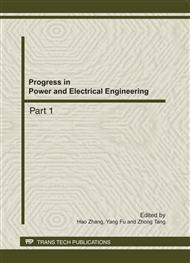p.1241
p.1245
p.1252
p.1257
p.1261
p.1265
p.1273
p.1278
p.1285
Parameter Calculation of Brushless Doubly-Fed Machine Based on the Genetic Algorithm
Abstract:
Because of special structure for the Brushless Doubly-Fed Machine (BDFM) and complex magnetic field coupling of different pole pairs, general parameter calculation and experiment methods are not accurate and fit for the BDFM. A parameter calculation method of the equivalent circuit for the BDFM based on the genetic algorithm (GA) is presented in this paper. The parameters of the equivalent circuit are considered as a group of unknown variables to solve the mathematical equation in different operating conditions. The difference between calculated and measured values is taken as a target function to be minimized through optimizing the parameters of the equivalent circuit by using the GA. The calculated results show that the method is valid to solve the related problems and it is suitable to be applied in the parameter calculation for the BDFM.
Info:
Periodical:
Pages:
1261-1264
Citation:
Online since:
October 2011
Authors:
Price:
Сopyright:
© 2012 Trans Tech Publications Ltd. All Rights Reserved
Share:
Citation:


